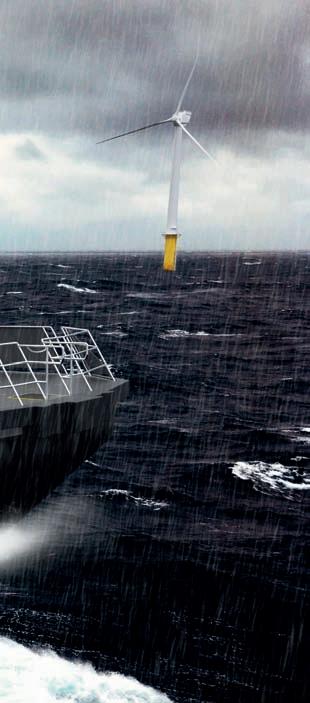
4 minute read
CWind Hybrid SES: New Crew Transfer
New Hybrid Crew Transfer Vessel
Wight Shipyard Co to Build revolutionary SurfaCe effeCt veSSel for offShore Market
offShore ServiCeS provider CWind haS ContraCted Wight Shipyard Co to Build the World’S firSt hyBrid SurfaCe effeCt CreW transfer vessel. It will service the Borssele 1 and 2 offshore windfarms located 23 kilometres off the Dutch coast.
All imAges CourteSy of Wight Shipyard Co.
CWind’s new hybrid crew transfer vessel will be the first of its kind. Wight Shipyard Co (WSC) will manage the build project from its development stage right through to delivery. The vessel will be a game-changer for the industry because of its ability to handle 2m significant wave height during technician transfer in heavy seas. At the same time, it will decrease fuel consumption and Co 2 emissions. “This vessel will be used around windfarm installations in the North Sea, where its motion-damped handling characteristics should allow it to outperform much larger vessels whilst consuming less fuel”, comments Martyn Drye, Director of engineering at CWind. According to WSC CEO Peter Mortin, CWind chose his shipyard because of its reputation and experience working with new designs and concepts, including hybrid vessels that reduce carbon emissions. “We have built a reputation in the fast ferry arena and commercial marine sector. But this a world first: building a hybrid SES fo r crew transfer. Building greener vessels has been an integral focus for some time now, so we are well-placed to lead this step change in Crew Transfer Vessels.”
Significant Fuel Savings The Hybrid SES propulsion engine will deliver sprint speed and extreme bollard push from its 1,600kW installed diesel engines, which can be battery boosted up to 1,878kW. The hybrid drive system will allow very quiet propulsion at slow speeds but also a significant boost mode to increase sprint speeds. >>
Wight Shipyard Co is building the world’s first hybrid surface effect crew transfer vessel to service the Borssele 1 and 2 offshore windfarms.

SPECS
Length overall Beam Forward deck space Max speed
Machinery Main engines Propulsion 22.00m 8.9m 30m 2 38 knots
2x Scania DI 16 076M@809kW 2x RR Kamewa s50-3/CA
The SES’s combination of electric infrastructure and battery availability will allow for immediate power delivery, coupled with greater fuel efficiency. Significant fuel savings will be achieved through balancing engine and inefficient low engine power running hours, with battery drive modes including windfarm standby and low speed/ harbour operations. This will lead to an engine operating hour reduction of 50% during windfarm battery standby. Digitalisation will be built into the hybrid SES so that machine learning begins from the day it sets sail. This means that crew will be able to make operational decisions and judgements based on both data collected over time and their own experience. “We embarked on the design of this revolutionary project last year, which utilises new technology to meet industry drivers for improved performance and reductions in carbon emissions”, adds Mr Drye. “We’re proud to be delivering a concept which is at the forefront of CTV innovation. WSC have been great to work with during the precontract stage and have embraced the new technology for this vessel. We are confident that they will deliver a high-quality solution, on time.”
Innovative Design The Hybrid SES crew transfer vessel was developed in partnership with the operator CWind and ESNA, a ship design company

based in Kristiansand, Norway, which specialises in commercially competitive vessels with surface effect technology to deliver significant carbon reductions. The vessel consists of two catamaran hulls, with the area between the hulls closed by flexible reinforced rubber fingers in the bow and an inflated rubber bag in the stern. Centrifugal fans blow air into this enclosed space, providing an air cushion that supports up to 80% of the vessel weight. The remaining 20% is supported by hull buoyancy. This allows for higher vessel speed because the hull resistance is significantly decreased. The air cushion is also used to compensate for wave induced motions. Because of this she allows for safe turbine boat landing We’re proud to be delivering a concept which is at the forefront of CTV innovation
access in higher wave heights than conventional crew boats of similar size. An added benefit is that the air cushion acts as a large shock absorber, improving the seakeeping and reducing seasickness. The overall design and build, with 24 passenger capacity, will pay particular attention to technician and crew health, safety and comfort, thus delivering the workforce in the best possible work-ready condition. “The vessel design will accommodate further developments in hybrid propulsion and battery technology, ensuring it has the capability of being developed into a totally carbon-free solution in the future”, explains Trygve Halvorsen Espeland, Naval Architect and Co-Founder
The vessel is scheduled for completion by the end of this summer and will operate from the Dutch port of Vlissingen to Borssele 1 and 2.

of ESNA. “Wight Shipyard Co was the obvious partner for the build because of its solid reputation for both quality timely builds and experience bringing a new concept hybrid vessel to market.”
Green Energy Ambition CWind’s long-term charter contract agreement with Ørsted, which operates the Borssele 1 and 2 offshore windfarms, will start in mid-2020. The agreement will cover an initial three-year firm charter with options available for a further two years. The new CWind Hybrid SES will enable Ørsted to deliver and service windfarms efficiently through reduced transit times, as well as support Ørsted’s green energy ambition. The vessel is scheduled for completion by the end of this summer and will operate from the Dutch port of Vlissingen to Borssele 1 and 2.
i. wightshipyard.com









